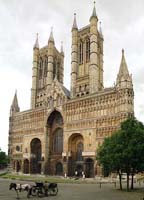| |
 |
Lincoln Lincoln Cathedral |
In 1067 Remigius, a monk of Fécamp in Normandy, became the first Norman to be appointed to an English see. This was at Dorchester-on-Thames, but it was moved in 1072 to the flourishing town of Lincoln. The earliest structure on the site of the cathedral appears to have been a substantial tower, similar to castles at Colchester and Tower of London, which formed a stronghold within the former Roman 'upper town' at Lincoln which had served as the castle bailey after the William the Conqueror arrived in 1068. One can still pick out the austere western façade of this structure which has a large central recess (the arch is 13th century) flanked by smaller recesses. The original western doorways have gone, but surviving capitals of a simple Corinthian form in the recesses are similar to examples in the Conqueror's abbey of St Stephen's in Caen apparently confirming the building's early date.
Construction of a cathedral on a cruciform plan to the east of the tower was largely complete by 1092. In the 1140s, Bishop Alexander, a true prince of the church with a love of display, made a number of alterations to the cathedral including demolition of the eastern part of the early Norman tower. He inserted new doorways into the recesses, which although now much restored, were clearly sumptuously carved. The jambs of the central portal had an elaborate programme of figures and beasts, and the arches of all three doorways feature beak heads and extravagant zig-zag. The influence of the abbey of St Denis near Paris has been detected, especially in the capitals of the north doorway.
Alexander may also have added the frieze showing biblical scenes below the string course on the original façade. Those from the Old Testament run to the south of the central doorway and those from the New Testament to the north. There is nothing else like this frieze in England and the idea may come from Modena cathedral in Italy.
Other work by Alexander included construction of two western towers of which the side walls are visible inside the cathedral. To be seen inside also are a tombstone, said to be Alexander's and a 12th century font made of black Tournai marble from Belgium.
In 1185 an earthquake damaged much of Lincoln cathedral and it was subsequently extensively rebuilt by Bishop Hugh of Avalon after 1192.
Bibliography
Gem, R.D.A., 1986. 'Lincoln Minster: Ecclesia Pura, Ecclesia Fortis', in Medieval Art and Architecture at Lincoln Cathedral, British Archaeological Association Conference Transactions 1982, 9-28
Pevsner, N and Harris, J., 1989. The Buildings of England, Lincolnshire (London, Penguin, revised ed. by N Antram), 444-9
Stocker, D. and Vince, A., 1997. 'The early Norman castle at Lincoln and a re-evaluation of the original west tower of Lincoln cathedral', Medieval Archaeology 41, 223-33
Zarnecki, G., 1988. Romanesque Lincoln: the Sculpture of the Cathedral (Lincoln)